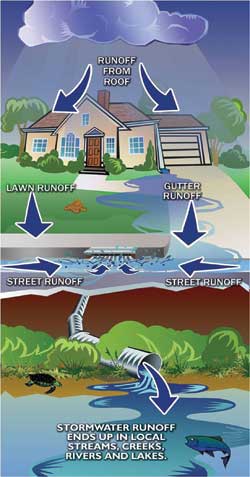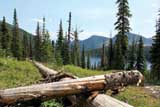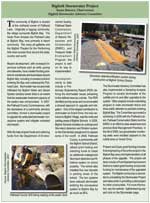Non-Point Source Pollution (Polluted Run-off)
Non-point Source (NPS) pollution is perhaps the greatest threat to water quality in the Flathead Watershed. NPS occurs when rainfall or snowmelt move over and through the ground, picking up natural and human-caused pollutants and depositing them into streams, rivers, lakes, and groundwater. NPS pollution originates from multiple sources and is difficult to directly measure. It is also responsible for the largest number of impaired miles of streams throughout the state of Montana.
Sources of this polluted runoff include:
- Excess fertilizers, herbicides, and insecticides from gardens, lawns, golf courses, and agricultural land
- Sediment from improperly managed construction sites, forestry or crop lands, and shorelines
- Erosion from stream banks, river banks, and lake shores
- Bacteria and nutrients from residential septic systems, pet and livestock waste, and pharmaceutical and personal care products (PPCPs)
- Oil, grease, and toxic chemicals from urban and suburban stormwater runoff
- Salt, sand, and chemicals from winter road maintenance and irrigation practices
- Airborne chemicals and particulates
 |
| Figure 5.4: Stormwater runoff. Source: NCDENR |
The diverse locations and unpredictability of these sources make managing and cleaning up after them difficult and costly. As runoff flows into streams, rivers, and lakes, pollutants are quickly dispersed into the watershed. Some pollutants (such as mercury) bioaccumulate as they move through the food web. This means they are absorbed and stored and can reach dangerous levels inside certain organisms.
Montana uses several principles for managing NPS pollution, including support of local conservation activities, comprehensive assessments of the water quality planning process, involvement in collaborative water quality programs, and process improvements using “adaptive management.”
Adaptive management is a process in which management plans take into account the dynamic nature of ecosystems and apply new knowledge and creativity to the management process. The State encourages citizens to protect existing clean water through the use of Best Management Practices (BMPs) and state-wide education and outreach (E&O) activities.
One of the biggest challenges in maintaining water quality in cities and towns is the increase in impervious surfaces, or surfaces that prevent rainwater and snowmelt from naturally soaking into the ground. These surfaces include roadways, parking lots, driveways, sidewalks, rooftops, and heavily compacted soil. As water flows across these hard surfaces, it picks up sediments, winter deicers, vehicle oil and grease, and other polluting substances and transports them into storm drains which lead directly to our waterways. Unlike porous terrain which allows water to filter into the ground, impervious areas cause runoff to accumulate above the surface and move in large quantities into surface waters.
Developers and homeowners can take steps to reduce sources of pollution and stormwater runoff by using pervious pavement, rain gardens, native landscaping, and soil restoration. It is also important to reduce the sources of contamination and pollution. The most prevalent pollutants are sediments, heavy metals, and nutrients generated by the activities that have traditionally driven our economy such as grazing, logging, mining, and development. Some things to consider:
Fertilizers: Fertilizers and animal waste add nitrogen and phosphorous to water and promote algae growth. The algae depletes the oxygen in the water and eventually can lead to the death of oxygen-dependent organisms. If Best Management Practices are not followed, agriculture, golf courses, lawns, and gardens can contribute an overabundance of nutrients in our waterways.
Pesticides and herbicides: Pesticides can injure and kill fish, amphibians, and other susceptible organisms—not just “pests”—when they wash into our waterways. Pesticide accumulation also poses a health hazard to humans. Pesticides and herbicides are used in agriculture, golf courses, lawns, and gardens.
Airborne pollutants: Pollutants carried by air currents travel enormous distances across land and water. Exhaust from cars, trucks and watercraft is a major source of nitrates, sulfates and heavy metals such as lead, mercury, and cadmium. Wildfires also contribute particles, carbon monoxide, and other pollutants to the air near and distant from fires. Fires release nitrogen oxides and hydrocarbons which can form another pollutant, ground level ozone, when these chemicals react in sunlight.


